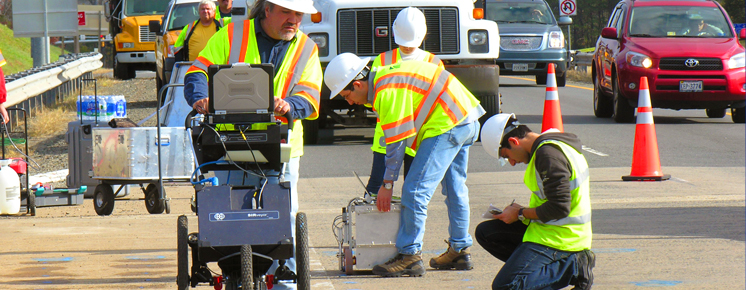
Better, faster methods for determining concrete bridge deck conditions.
Nondestructive Testing for Concrete Bridge Decks (R06A)
Challenge
The number of concrete bridge decks in poor structural condition is one of the biggest problems affecting bridges in the United States. Evaluating bridge deck conditions becomes increasingly critical as highway agencies work to optimize the effective timing, scope, and approaches for preventive maintenance, repair, and replacement.
Normal chain dragging, hammer sounding, and visual methods of identifying concrete bridge deck deficiencies do not accurately and safely provide the needed information to adequately maintain concrete bridge decks. Nondestructive testing (NDT) techniques have the potential to quickly and reliably provide the needed information about under-the-surface conditions of bridge decks, but independent evaluations are needed to determine their best use and to validate their effectiveness under a variety of conditions.
Solution
The web-based, open-source NDToolbox helps identify and characterize testing technologies that are available to locate the primary deficiencies in concrete bridge decks. With the toolbox, users can explore different NDT technologies and examine their use in detecting deterioration for conditions relevant to the project. The NDToolbox describes the technology and the physical principle behind it, applications, performance, limitations, equipment, test procedures and protocols, and sample results. It also provides recommendations regarding the best technologies for a particular deterioration detection application.
The accompanying report identifies the four most common types of deterioration affecting concrete bridge decks, and the corresponding NDT techniques that are best suited to locating and identifying the deterioration. Based on their overall value in detecting and characterizing deterioration in concrete decks, the top technologies were ground-penetrating radar, impact echo, and ultrasonic surface waves. The report and web tool provide clear information about the advantages and limitations of each technology. However, the ultimate decision about which equipment to acquire and which technology to use is dependent on the type of deterioration that is of highest concern to the agency, and whether the evaluation is being done for network-level condition monitoring or for project-level maintenance or rehabilitation.
Benefits
Comprehensive and accurate assessments of concrete bridge decks can reduce the frequency of detailed regular and follow-up inspections. This can reduce the number of congestion-related traffic interruptions, which, in turn, can provide shorter durations and frequencies of work zones during testing operations. In addition, a number of NDT technologies can generate data at production rates that are comparable to the current practice of chain dragging and hammer sounding. The cost of these techniques is also approaching traditional testing values.
-

Save Lives
Minimizes the likelihood of bridge failures from unrecognized bridge deck deterioration. Creates safer conditions for workers because of shorter exposure in work zones.
-

Save Money
Provides options for cost-effective evaluation of bridge deck deficiencies.
-

Save Time
Extends the life of concrete bridge decks through appropriate and timely maintenance treatments.


